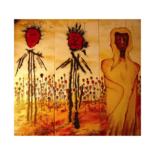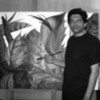Maigó no campo de milho quando o autor tinha quatro anos Pintura por Aristides Menezes
Não está à venda
Vendido por Galeria de Arte da Albuquerque e Lima
-
Obras de arte originais
Pintura,
Óleo
- Dimensões Altura 57,9in, Largura 52,4in
- Categorias Pinturas menos de US$ 5.000
Maigó at the maize field when A. M. was four years old
133 cm x 147 cm (1000 Euros cada painel / 3000 Euros os três painéis)
2010, Tinta da Índia e Óleo sobre Tela, 133 cm x 147 cm (três painéis)
Temas relacionados
Born in 1958 in Lourenço Marques, nowadays called Maputo, in Mozambique, located in the east coast of Africa, Aristides Meneses descended from a family that in the last hundred years has lived in three continents. His grandparents, who where from Goa, in Asia, left India to that country, which at that time was a Portuguese colony, and settled there. Both his parents where born in Africa, in Lourenço Marques, the father and in Inhanbane, the mother. They lived there until they had to move to Portugal where they now live. Due to that confluence, Aristides Meneses has been influenced by three cultures, from the Asian, due to his ascendants, to the European, through language, history and political environment, including the African, because he lived there until he was sixteen. In a discreet and subtle way, all his work reflects that multiplicity of influences and, although the European culture is dominant, one can find more or less explicit references to the others in a large number of his works.
He started to paint in Mozambique, doing so as any child who liked to draw and paint images on paper, real or imaginary, working with colour pencils, watercolors, pastel and other techniques. But unlike other children, painting interested him dearly, and started to grow in importance. Without doubt those years in Africa had an enormous influence on him.
The large open spaces, the time that seemed to allow almost anything, the beach until darkness, long roads lined with trees, the conversations and parties in the open space are just a few examples of fond memories reflected in his paintings, even if they are the end result of a subconscious process. The openness of the mind appears associated to an open attitude, fearless of showing to a point that surprises some of the most critical minds, because the painter allows to expose himself on canvas in a very intense way, as in “Self portrait at one hundred years” (1983), arguably one of his most interesting paintings. Literally painted in front of a mirror, it was the result both of an image inversion exercise and of an introspective analysis, which brought to the canvas a strong and moving portrait. And, as in many of his works, it seems to draw the observer to the inside, as if it was their own portrait, dispossessed and alone, but with much inner strength. And so, instead of being a frightening painting, because it must be frightening to imagine oneself with a hundred years old, it is in fact soothing. At the end it is no more that a phase characterized by one knowledge.
Of the work completed in Africa, with an orientation to the realistic and naturalistic, only one small painting survived, “Oasis”, executed with pastel on paper by 1971. The caravels of the Portuguese Discoveries, the sea and the African landscapes, all were themes of his work during his youth, with which he entered some painting exhibitions. During the last years he lived in Mozambique he started to use indian ink painted and blow...
-
Nacionalidade:
PORTUGAL

- Data de nascimento : 1958
- Domínios artísticos: Representado por uma galeria,
- Grupos: Artistas Portugueses Contemporâneos Artistas apresentados por uma galeria




